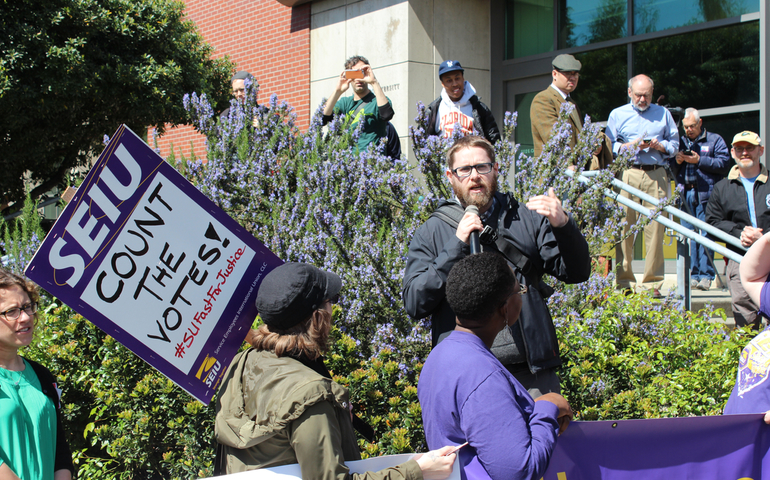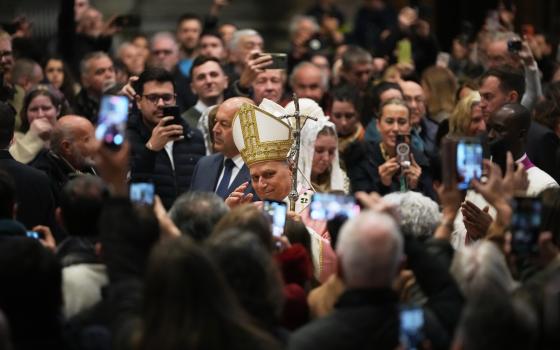
Ben Stork speaks at a union rally at Seattle University April 14. (SEIU Local 925)
When Ben Stork applies for full-time teaching jobs, the adjunct film studies professor knows his résumé lands in voluminous piles. “When I’m granted a rejection letter, it almost always comes with the first line, ‘We received between 300 and 500 applications for this position,’ ” he said. “That gives you a sense of the sort of competition for tenure-line jobs.”
As an adjunct, Stork faces a Sisyphean workload. Contracts, which are short-term, can arrive mere days before classes start. Adjuncts aren’t paid for preparation time when courses that miss enrollment benchmarks are canceled. And Stork has retooled syllabuses and teaching plans after a recent contract changed the titles of two assigned classes.
“You can imagine folks not knowing what they’re teaching quarter to quarter,” he said. “If they’re teaching.”
These challenges are becoming increasingly common. In 1969, full-time, tenure-track professorships made up nearly 80 percent of teaching roles at nonprofit schools, noted the Association of Governing Boards of Universities and Colleges. Today, more than 73 percent of faculty is contingent (non-tenure), according to the American Association of University Professors. And, the professors association adds, more than half of faculty appointments today are contingent.
On average, contingent faculty earn $2,700 per three-credit course at two- and four-year colleges and universities, and $3,400 per three-credit course at research institutions, according to the nonprofit New Faculty Majority.
Stork teaches in the English department at Seattle University, a Jesuit school with more than 7,400 students and an annual operating budget of $190 million. The university is currently fighting part-time faculty’s efforts to organize and unionize.
Tension on campus is “fairly palpable. It’s weighing on everyone,” Stork said. “It’s really pushing against the narrative of Seattle University as a Jesuit institution devoted to social justice.”
For its part, the university is balking at the involvement of the National Labor Relations Board (NLRB), a government agency, which it says trounces on its First Amendment rights. The university stressed its support for unions and noted that seven unions on campus represent 63 staff members*. The NLRB, however, is unwelcome.
Last month, the NLRB counted votes that contingent Seattle University faculty cast two years ago -- which Seattle University fought -- and found that the faculty had voted to unionize. The university is suing, however, saying that the NLRB doesn't have jurisdiction.
“In upholding the right of faith-based institutions to carry out their core educational mission free from government intrusion, the courts have repeatedly pointed to the inherent First Amendment concerns and problems with NLRB oversight,” said Seattle University president Jesuit Fr. Stephen Sundborg. “The courts have shared examples where NLRB involvement — including specifically with ‘lay teachers’ — would necessarily involve unconstitutional interference with the school’s faith-based educational mission.”
The responsibility of carrying out Seattle University’s faith-based educational mission falls on all of its faculty, according to Sundborg. “Our Jesuit Catholic education is based on educating the whole person — mind, body and spirit. It pervades our entire educational mission and all that we teach our students,” he said. “Ceding authority to the NLRB, a government entity, could lead to long-term consequences for our Jesuit education and Catholic identity. The potential for erosion of either is a real concern.”
Michael Galligan-Stierle, president of the Association of Catholic Colleges and Universities, which represents 238 institutions in the U.S. and overseas, worries about the same erosion.
“Our concern is that the NLRB demands to be the final authority on determining if a college is ‘Catholic enough’ to justify exemption from labor laws. The Supreme Court has clearly ruled that the NLRB has no authority to manage relations between a religious educational institution and its faculty,” Galligan-Stierle said. “Any of our colleges that has chosen to resist NLRB intervention has merely exercised its rights as defined by the U.S. Supreme Court.”
If the NLRB is permitted to intervene, he cautioned, the stage will be set for schools’ Catholic identities, which are part of hiring, curriculum development and other operational decisions, to become “points of negotiation.”
The NLRB, then, would be “analyzing and determining the college or university’s religious mission and employees’ role in furthering that mission,” he said.
‘Chicken Little’
Others are unconvinced by Seattle University’s fears.
“It strikes me as a bit of a Chicken Little kind of example,” said Joseph McCartin, director of Georgetown University’s Kalmanovitz Initiative for Labor and the Working Poor.
“They are arguing that by letting the NLRB onto campus in any fashion it seems like it’s going to endanger the religious character of their university and their ability to carry that out,” McCartin said. “I just don’t think there’s any evidence for that.”
“I find the argument a bit bogus,” echoed John Pauly, chair in communication and in journalism and media studies at Marquette University, a Catholic school in Milwaukee, and Marquette’s provost from 2008 to 2013.
A common refrain among critics of Seattle University’s position is the growing number of Catholic schools that are negotiating with faculty unions without jeopardizing their religious identities or autonomy. According to a Service Employees International Union (SEIU) spokesman, adjunct faculty at 12 Catholic schools have sought to form unions with the SEIU in the past three years:
- St. Martin’s University (Lacey, Wash.), Seattle University, and Loyola University Chicago are currently appealing NLRB involvement.
- Georgetown, St. Mary’s College of California, St. Michael’s College (Vermont), Dominican University of California, and Trinity Washington University (D.C.) have secured contracts.
- Holy Names University (California), Notre Dame de Namur University (California), Siena College (New York), and St. Louis University are in the bargaining process.
When the part-time faculty at Georgetown sought to unionize recently, the university provost sent a letter to faculty referring them to Georgetown’s just employment policy, which affirms employees’ right to organize. The letter also directed those with further questions to visit the NLRB website, which meant that the university maintained from the start that there was no conflict between its religious mission and NLRB intervention, according to McCartin.
“There was nothing about that process that led to any kind of endangerment of religious freedom here,” he said.
Historically, the Catholic church has defended collective bargaining. “That’s the sad thing about what Seattle is doing,” McCartin said. “This is a real step backward by some leading figures in Catholic higher education. I think that they are really crafting an idea that this going to be far more dangerous — I actually don’t see it as being dangerous at all.”
At Notre Dame de Namur University in Belmont, Calif., which is part of the same order as Trinity Washington University, the faculty was aware of other concurrent unionizing efforts at Dominican and St. Mary’s, said Kim Tolley, a professor of education at Notre Dame de Namur and editor of the forthcoming book Adjunct Higher Ed: The Unionization of Contingent Faculty in the United States.
Tolley is aware of national debates about whether the NLRB will endanger schools’ religious identities. “I think our position always was that this is not a Catholic issue. This is just certain individual schools deciding they don’t want a union on their campus,” she said.
“I don’t know how Seattle is going to go to court and argue that because they’re a Catholic school, they can’t unionize,” Tolley said.
Nor does she understand the Jesuit schools that are fighting NLRB intervention. “If that’s what they felt was the hindrance, they could have just held a card check and avoided going through the NLRB,” she said.
Seattle University is willing to bargain with contingent faculty “under an alternative, cooperative framework once the jurisdictional dispute is resolved,” said Sundborg. “Neither side can simply waive the NLRB’s jurisdiction, which is why it is necessary to seek court review.”
Scott Jaschik, editor of Inside Higher Ed, which has been covering adjunct unionizations extensively, thinks NLRB intervention on Seattle’s campus will be appealed up to the Supreme Court, no matter how the district court rules.
Religious duties
A key question is how religious the duties of most adjunct professors are.
“If we were talking about tenured professors of theology, I suspect Seattle would prevail,” Jaschik said. “But many adjuncts are teaching first-year composition or math, and they report that their jobs — and their desire for better pay and benefits — aren’t that different at religious or secular institutions.”
The desire for better pay and benefits for adjuncts comes at a time that the academic landscape has changed drastically, experts said.
According to Pauly, adjuncts get paid the same per-credit rate ($1,000) at Marquette today as they did in 1995 at St. Louis University, where he was then a department chair.* And adjunct roles are no longer what they used to be, where those with full-time jobs outside the academy shared that expertise with students. “We never thought that being a part-timer would be a way of making a living,” he said.
At Seattle University, Stork is convinced that the university’s religious argument is “disingenuous,” since it can’t point to an example of unions threatening a school’s religious identity.
“This is another distraction and another way for them to spin what I think is fundamentally a financial decision. This is about having the flexibility to pay almost half of their instructional faculty less, and to have the flexibility to shed them when necessary,” he said.
The university’s position, he said, is an affront to academic freedom. “This ability that they want is essentially for them to not only manage their costs, but also to manage their workforce as a body of intellectuals,” he said. “This really points to something that goes significantly against its educational mission as a university.”
Stork’s priorities are securing contracts that guarantee seven courses over three quarters, rather than four. He noted that he currently has benefits, which is one thing Seattle University has done well. But he’d like a path to promotion within a “very perverse” system, in which adjuncts are at institutions’ whims, no matter how well they teach or how much research they create. They’re treated “as if this were just a hobby for them,” he said.
“There’s no clear path for me to advance to full-time work regardless of the quality of instruction I provide, regardless of how well I do, how much scholarship I produce,” he said. “It’s the scarlet ‘A.’ You carry around the mark of the adjunct. It’s the mark of failure.”
A growing number of doctorate holders can’t find tenure jobs for reasons that may have nothing to do with merit, noted Georgetown’s McCartin. “The academic labor market is so specialized that you could end up in Washington, D.C., and be a 20th-century U.S. social historian, but actually there is no available job in D.C.,” he said. “Maybe here and there people have a course they need taught.”
And once faculty get into the cycle of adjunct teaching, they find themselves underpaid and without institutional support to conduct research, which is the very thing that could help propel them into full-time roles. “You don’t get to publish like a tenure-track professor would,” McCartin said. “So you fall behind the curve, and that makes it harder to get a tenure-track job.”
At Notre Dame de Namur, where about 80 percent of the faculty is part-time, the adjunct faculty try their best, but they’re set up to fail, said Tolley. Students often ask in surveys why their professors seem to disappear immediately after class ends. “Well, they’ve gone off to teach at the next institution down the road,” she said.
Tolley asked critics to imagine sending their children to an elementary school where the child would learn from a slew of part-timers, rather than a full-time teacher. “There’s no one out there that would want to have their children K-12 taught by a stream of adjuncts,” she said.
Focus of funding
At an institutional level, universities can manage enrollment better, so they ought to be able to give adjunct professors more advance notice. And they should be able to offer more courses.
“The reason they don’t want to do that is because they don’t want to offer health benefits,” she said. “We heard about this happening at McDonald’s. Everyone is just working piecemeal without benefits. It’s hurting the quality of our academic programs.”
And if universities focused their funding elsewhere, there’d be enough money to go around. When she receives fundraising communications from her alma mater, University of California, Berkeley, Tolley noted it’s always about building multimillion-dollar buildings. When Tolley, 65, went to University of California, Santa Cruz as a student, she doesn’t remember such fancy dorms.
“It’s become the thing that every administrator wants to have on his or her résumé,” she said.
Unions, she said, have no reason to try to force universities down financial paths that will put them out of business. “When an administration gets in panic mode, they’re forgetting that the employees don’t want to see their college or university go out of business. That’s not in the interest of the employees or the union,” she said.
McCartin agrees. “Why would a union want to pursue a policy that would bring down the very universities that it’s trying to organize?” he asked.
Nor, he added, would the union want to overturn a school’s religious mission. “It recognizes that that’s an important reason for their existence and how they came about,” he said.
The ultimate goal at Seattle University seems to be to avoid unionization, according to McCartin. “Georgetown has a policy. Why doesn’t Seattle?” he said.
McCartin is also skeptical of claims that better pay for adjuncts could put schools out of business. “I bet in every case you’ll find that administrative costs have gone up faster than have faculty salaries,” he said. “Administrative bloat is a problem at a lot of these places.”
The national conversation about finding sustainable higher education models can’t take place without the representation of the most powerless and marginalized voices within the academy. “Right now, they don’t have much of a voice,” he said.
Still, Pauly, the former provost and dean, said there’s a cultural issue at play on Catholic campuses. Catholic universities see themselves metaphorically as families, which makes union contracts uncomfortable. “There is legitimate concern that negotiating with unions complicates and bureaucratizes relationships with employees,” he said.
That’s all the more reason, he added, that there needs to be a rethinking of the mechanics of higher education, in which faculty may have to teach more, or teach more introductory courses. The right combination of traditional tenured faculty and non-tenure-track faculty could pave the way for a more hopeful and sustainable model.
*An earlier version of this story incorrectly stated that the unions represented 63 non-tenured faculty, and listed an incorrect title for Pauly at St. Louis University in 1995.
[Menachem Wecker is co-author of the book Consider No Evil: Two Faith Traditions and the Problem of Academic Freedom in Religious Higher Education.]



